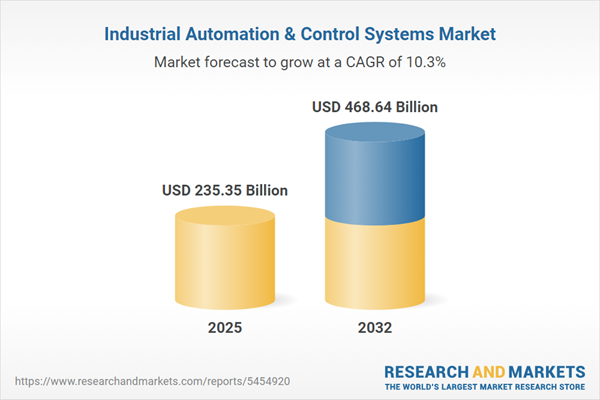Speak directly to the analyst to clarify any post sales queries you may have.
Industrial automation and control systems are driving a paradigm shift for manufacturers and asset operators, blending technological advancement with strategic decision-making. This executive analysis equips business leaders with forward-looking intelligence to optimize operations, mitigate risk, and capitalize on evolving market dynamics.
Market Snapshot: Industrial Automation & Control Systems
The Industrial Automation & Control Systems Market grew from USD 213.24 billion in 2024 to USD 235.35 billion in 2025. It is expected to continue growing at a CAGR of 10.34%, reaching USD 468.64 billion by 2032. This market expansion underscores rising adoption across manufacturing, energy, process industries, and related verticals globally. Intensifying focus on digital transformation, advanced connectivity, operational resilience, and sustainability is shaping procurement and investment patterns among enterprises, fostering innovation across established and emerging economies.
Scope & Segmentation: Strategic Market Coverage
- Component Types: Hardware (connectivity devices, controllers, field devices, human machine interface), services (managed and professional), and software (application, device management, middleware, SCADA).
- System Types: Distributed control systems and hybrid variants, HMIs, programmable automation controllers, PLCs (compact, modular, rack-mount), safety instrumented systems, and SCADA (open architecture, proprietary).
- Industry Verticals: Automotive, energy and power, food and beverage, manufacturing (discrete, hybrid, process), oil and gas, pharmaceuticals, water and wastewater sectors.
- Communication Protocols: EtherCAT, Ethernet/IP, HART, Modbus, Profibus, Profinet, WirelessHART.
- Deployment Models: Cloud (public and private), hybrid, on-premises.
- Geographic Regions: Americas (North America, Latin America), Europe, Middle East & Africa (including GCC, Western and Eastern Europe, select African markets), and Asia-Pacific (China, Japan, India, Southeast Asia, Australia, and others).
- Company Coverage: Siemens AG, Schneider Electric SE, Mitsubishi Electric Corporation, ABB Ltd, Rockwell Automation, Emerson Electric, Honeywell International, Yokogawa Electric, Omron Corporation, and Fanuc Corporation.
Key Takeaways for Decision-Makers
- Integration of edge computing and artificial intelligence within automation systems is facilitating real-time analytics, predictive maintenance, and autonomous decision-making, empowering agile operations.
- Widespread adoption of open communication standards and protocols enhances interoperability across vendor ecosystems, reducing platform lock-in and simplifying future upgrades.
- Professional and managed services models are gaining prominence, allowing enterprises to shift capital-intensive investments to operational expenses while optimizing asset performance and lifecycle management.
- Strategic focus on workforce upskilling and cybersecurity best practices remains crucial to secure digital infrastructure and extract value from data-driven automation environments.
- Customization and modularity in automation solutions enable cross-industry adaptability, streamlining compliance, and supporting ESG-focused priorities.
Tariff Impact: Implications for Supply Chain and Adoption
United States tariffs enacted in 2025 have significantly impacted sourcing strategies and operational costs related to industrial automation hardware and select services. Manufacturers are responding by re-evaluating procurement footprints, exploring regional supply chain alternatives, leveraging nearshoring, and adopting cloud-based deployment models to reduce reliance on costly imports. These adjustments have driven renegotiation of service agreements and, in some cases, adoption of platform consolidation strategies to optimize expenses and operational continuity. Leaders navigating this complex landscape should remain vigilant of evolving fiscal policies and policy-driven risks as they craft resilient procurement and growth strategies.
Methodology & Data Sources
This report relies on rigorous primary interviews with industry stakeholders, system integrators, and regional experts for actionable insights. Secondary research includes technical publications, regulatory filings, company reports, and association data. All figures have been validated and normalized using data triangulation methods, ensuring robust accuracy and consistency for strategic planning.
Why This Report Matters: Actionable Intelligence for Leaders
- Enables strategic planning by mapping technology trends, segmentation detail, and regional nuances critical for investment decisions.
- Provides comprehensive vendor, service, and deployment landscape analysis for tailored procurement and platform selection.
- Delivers evidence-based guidance on risk mitigation, operational optimization, and long-term competitive differentiation.
Conclusion
This report empowers senior leaders to navigate transformative shifts in automation with clarity and agility. A robust understanding of drivers, barriers, and emerging solutions enables organizations to optimize operational resilience, competitiveness, and growth potential.
Additional Product Information:
- Purchase of this report includes 1 year online access with quarterly updates.
- This report can be updated on request. Please contact our Customer Experience team using the Ask a Question widget on our website.
Table of Contents
3. Executive Summary
4. Market Overview
7. Cumulative Impact of Artificial Intelligence 2025
List of Figures
Samples

LOADING...
Companies Mentioned
The key companies profiled in this Industrial Automation & Control Systems market report include:- Siemens AG
- Schneider Electric SE
- Mitsubishi Electric Corporation
- ABB Ltd
- Rockwell Automation, Inc.
- Emerson Electric Co.
- Honeywell International Inc.
- Yokogawa Electric Corporation
- Omron Corporation
- Fanuc Corporation
Table Information
| Report Attribute | Details |
|---|---|
| No. of Pages | 195 |
| Published | October 2025 |
| Forecast Period | 2025 - 2032 |
| Estimated Market Value ( USD | $ 235.35 Billion |
| Forecasted Market Value ( USD | $ 468.64 Billion |
| Compound Annual Growth Rate | 10.3% |
| Regions Covered | Global |
| No. of Companies Mentioned | 11 |









